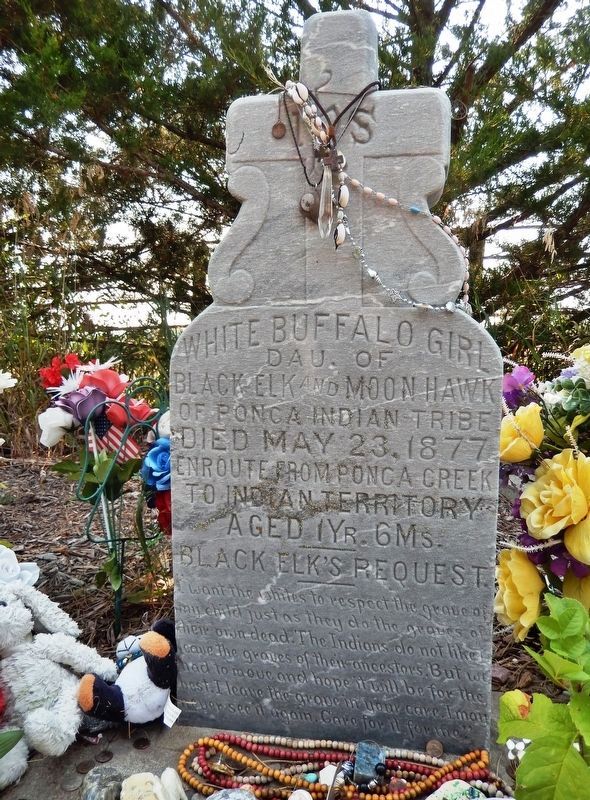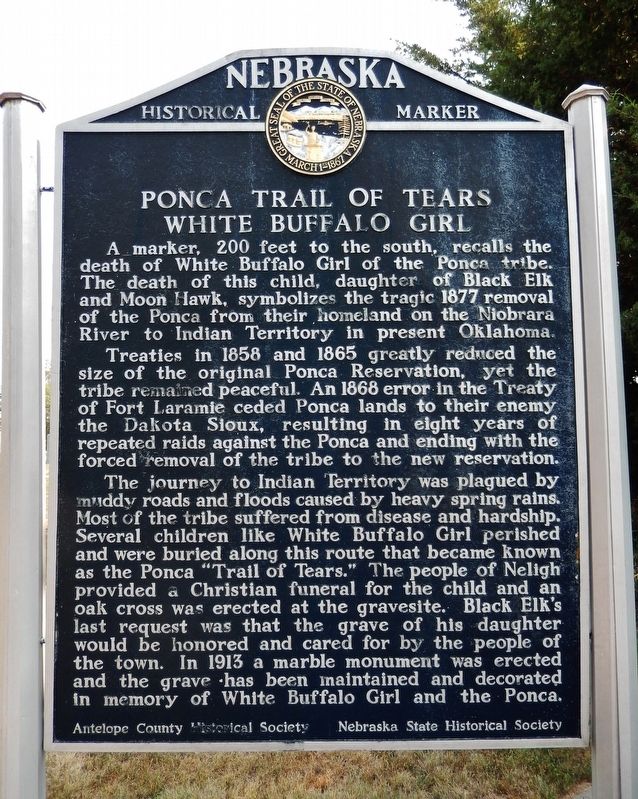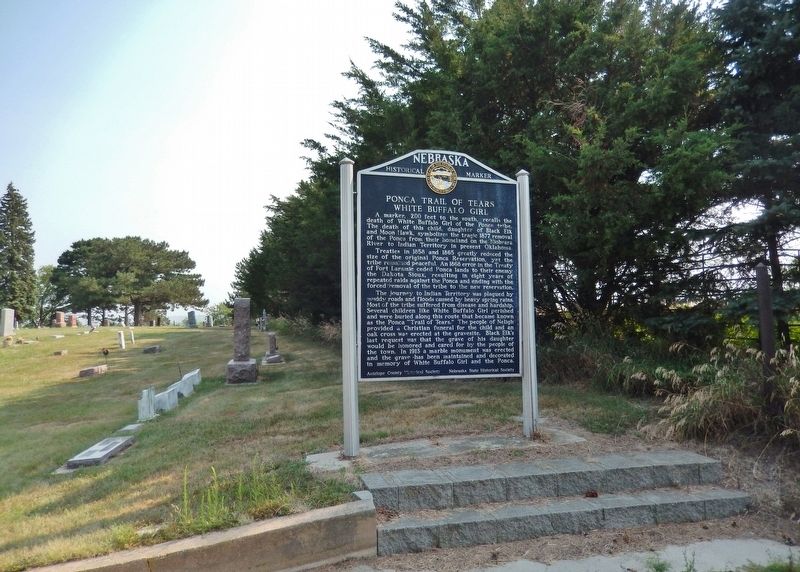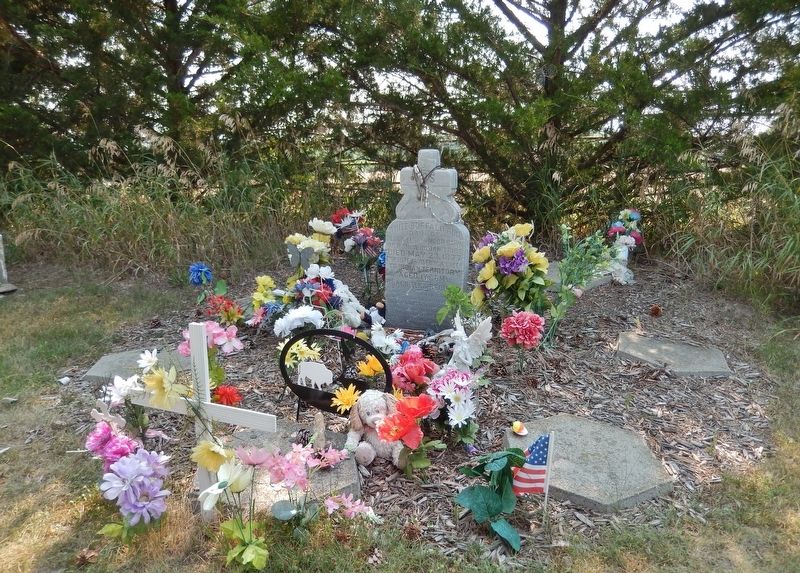Neligh in Antelope County, Nebraska — The American Midwest (Upper Plains)
Ponca Trail of Tears
White Buffalo Girl
A marker, 200 feet to the south, recalls the death of White Buffalo Girl of the Ponca tribe. The death of this child, daughter of Black Elk and Moon Hawk, symbolizes the tragic 1877 removal of the Ponca from their homeland on the Niobrara River to Indian Territory in present Oklahoma.
Treaties in 1858 and 1865 greatly reduced the size of the original Ponca Reservation, yet the tribe remained peaceful. An 1868 error in the Treaty of Fort Laramie ceded Ponca lands to their enemy the Dakota Sioux, resulting in eight years of repeated raids against the Ponca and ending with the forced removal of the tribe to the new reservation.
The journey to Indian Territory was plagued by muddy roads and floods caused by heavy spring rains. Most of the tribe suffered from disease and hardship. Several children like White Buffalo Girl perished and were buried along this route that became known as the Ponca “Trail of Tears.” The people of Neligh provided a Christian funeral for the child and an oak cross was erected at the gravesite. Black Elk’s last request was that the grave of his daughter would be honored and cared for by the people of the town. In 1913 a marble monument was erected and the grave has been maintained and decorated in memory of White Buffalo Girl and the Ponca.
Erected by Antelope County Historical Society; and Nebraska State Historical Society. (Marker Number 138.)
Topics and series. This historical marker is listed in these topic lists: Cemeteries & Burial Sites • Native Americans • Settlements & Settlers. In addition, it is included in the Nebraska State Historical Society, and the Trail of Tears series lists. A significant historical date for this entry is May 23, 1877.
Location. 42° 8.405′ N, 98° 1.582′ W. Marker is in Neligh, Nebraska, in Antelope County. Marker is on County Road 198, 0.1 miles east of L Street (524th Road), on the right when traveling east. Marker is located approximately at the center of Laurel Hill Cemetery. Touch for map. Marker is in this post office area: Neligh NE 68756, United States of America. Touch for directions.
Other nearby markers. At least 8 other markers are within 12 miles of this marker, measured as the crow flies. The Rainbow Fountain (approx. one mile away); The Neligh Mills (approx. one mile away); Trails, Rails, and Roads: Lifelines of a Mill (approx. one mile away); Water Power at the Neligh Mill (approx. one mile away); The Neligh Mill Bridge (approx. one mile away); Tilden, Nebraska (approx. 11.7 miles away); Tilden Veterans Memorial (approx. 11.9 miles away); Veterans Memorial Flag (approx. 11.9 miles away). Touch for a list and map of all markers in Neligh.
Also see . . .
1. White Buffalo Girl
. The removal of the Ponca Tribe from its ancestral homeland in northern Nebraska remains part of one of the darkest chapters in the history of Euro-American treatment of the native populations. The Ponca refused to leave Nebraska. They were forcibly removed and sent south in 1877. Their journey, the Ponca "Trail of Tears," and subsequent resettlement resulted in the death of one-third of the tribe from hardship and disease within a year. White Buffalo Girl's death was an early part of this tragedy. (Submitted on September 17, 2021, by Cosmos Mariner of Cape Canaveral, Florida.)
2. The Legacy of White Buffalo Girl, and the Resiliency of a People. Like so many others here, it’s a small monument to loss, but alone among the thousands of such markers, this one is perpetually covered in votive offerings: coins, toys, beads, flowers and more, a pop of unexpected vibrancy in stark contrast to its surroundings. By cemetery policy, this is the only headstone allowed to be so adorned year-round. The gravesite represents grief, suffering and a historic injustice — but it’s also a monument to hope and a tangible reminder of one small town’s commitment to honoring a promise made long ago. (Submitted on September 17, 2021, by Cosmos Mariner of Cape Canaveral, Florida.)
3. White Buffalo Girl's Grave. In May of 1877, after endless haggling and heartless bureaucratic inertia, someone in
faraway Washington determined that the Poncas of Nebraska would be forced to leave their villages, their homes and schools and churches, their sawmill and their flour mill and everything they owned, and walk to Oklahoma. Imagine 500 people in soggy early May trudging up and down endless muddy hills along the Missouri. Imagine never-ending rains that made some days impossible to travel. On May 23, not far from the Elkhorn River and near a tiny frontier town named Neligh, the little daughter of Black Elk and Moon Hawk, succumbed to pneumonia. White Buffalo Girl was all of 18 months. (Submitted on September 17, 2021, by Cosmos Mariner of Cape Canaveral, Florida.)

Photographed By Cosmos Mariner, August 8, 2021
4. White Buffalo Girl Headstone
Dau. Of
Black Elk and Moon Hawk
of Ponca Indian Tribe
Died May 23, 1877
enroute from Ponca Creek
to Indian Territory
Aged 1 Yr. 6 Ms.
• • •
Black Elk’s Request
”I want the whites to respect the grave of
my child just as they do the graves of
their own dead. The Indians do not like
leave the graves of their ancestors. But we
had to move and hope it will be for the
best. I leave the grave in your care. I may
never see it again. Care for it for me.”
Credits. This page was last revised on September 17, 2021. It was originally submitted on September 17, 2021, by Cosmos Mariner of Cape Canaveral, Florida. This page has been viewed 543 times since then and 82 times this year. Photos: 1, 2, 3, 4, 5. submitted on September 17, 2021, by Cosmos Mariner of Cape Canaveral, Florida.



